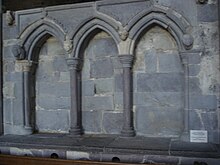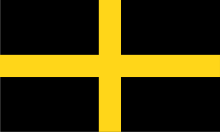Legend
His best-known miracle is said to have taken place when he was preaching in the middle of a large crowd at the Synod of Brefi: the village of Llanddewi Brefistands on the spot where the ground on which he stood is reputed to have risen up to form a small hill. A white dove, which became his emblem, was seen settling on his shoulder. John Davies notes that one can scarcely "conceive of any miracle more superfluous" in that part of Wales than the creation of a new hill.[6] David is said to have denounced Pelagianism during this incident and he was declared archbishop by popular acclaim according to Rhygyfarch,[7] bringing about the retirement of Dubricius. St David's metropolitan status as an archbishopric was later supported by Bernard, Bishop of St David's, Geoffrey of Monmouth and Gerald of Wales.
The Monastic Rule of David prescribed that monks had to pull the ploughthemselves without draught animals,[5] must drink only water and eat only bread with salt and herbs, and spend the evenings in prayer, reading and writing. No personal possessions were allowed: even to say "my book" was considered an offence. He lived a simple life and practised asceticism, teaching his followers to refrain from eating meat and drinking beer. His symbol, also the symbol of Wales, is the leek (this inspires a reference in Shakespeare's Henry V, Act V scene 1) :
Fluellen: "If your Majesty is remembered of it, the Welshmen did good service in a garden where leeks did grow, wearing leeks in their Monmouth caps, which your Majesty knows, to this hour is an honourable badge of the service, and I do believe, your Majesty takes no scorn to wear the leek upon Saint Tavy's day". King Henry: "I wear it for a memorable honour; for I am Welsh, you know, good countryman".
Death
Though the exact date of his death is not certain, tradition holds that it was on 1 March, which is the date now marked as Saint David's Day.[9] The two most common years given for his death are 601 and 589. The monastery is said to have been "filled with angels as Christ received his soul." His last words to his followers were in a sermon on the previous Sunday. The Welsh Life of St David gives these as: "Arglwydi, vrodyr, a chwioryd, Bydwch lawen a chedwch ych ffyd a'ch cret, a gwnewch y petheu bychein a glywyssawch ac a welsawch gennyf i. A mynheu a gerdaf y fford yd aeth an tadeu idi",[10] which translates as, "Lords, brothers and sisters, Be joyful, and keep your faith and your creed, and do the little things that you have seen me do and heard about. And as for me, I will walk the path that our fathers have trod before us." "Do ye the little things in life" ("Gwnewch y pethau bychain mewn bywyd") is today a very well known phrase in Welsh. The same passage states that he died on a Tuesday, from which attempts have been made to calculate the year of his death.
David was buried at St David's Cathedral at St David's, Pembrokeshire, where his shrine was a popular place of pilgrimage throughout the Middle Ages. During the 10th and 11th centuries the Cathedral was regularly raided byVikings, who removed the shrine from the church and stripped off the precious metal adornments. In 1275 a new shrine was constructed, the ruined base of which remains to this day (see photo), which was originally surmounted by an ornamental wooden canopy with murals of St David, St Patrick and St Denis of France. The relics of St David and St Justinian were kept in a portable casket on the stone base of the shrine. It was at this shrine that Edward I came to pray in 1284. During the reformation Bishop Barlow (1536–48), a staunch Protestant, stripped the shrine of its jewels and confiscated the relics of David and Justinian.
Veneration
David was officially recognized at the Vatican by Pope Callixtus II in 1120, thanks to the work of Bernard, Bishop of St David's. Music for his office has been edited by O.T. Edwards in Matins, Lauds and Vespers for St David's Day: the Medieval Office of the Welsh Patron Saint in National Library of Wales MS 20541 E (Cambridge, 1990). David was also canonized by the Eastern Orthodox Church at an unknown date.
Over 50 churches in South Wales were dedicated to him in pre-Reformation days.[5]
In the 2004 edition of the Roman Martyrology, David is listed under 1 March with the Latin name Dávus. He is recognised as bishop of Menevia in Wales who governed his monastery following the example of the Eastern Fathers. Through his leadership, many monks went forth to evangelise Wales, Ireland, Cornwall and Armorica (Brittany and surrounding provinces).[11]
The restored Shrine of St David was unveiled and re-dedicated by the Right Reverend Wyn Evans, Bishop of St Davids, at a Choral Eucharist on St David's Day 2012.
Local tradition says that during a battle against the Saxons, David advised the Welsh warriors each to wear a leek in his hat or armour so that the warriors might distinguish themselves from their enemies. Ever since then, the Welsh wear leeks every 1 March in memory of David.[12]
Reputation
David's popularity in Wales is shown by the Armes Prydein Fawr, of around 930, a popular poem which prophesied that in the future, when all might seem lost, the Cymry (the Welsh people) would unite behind the standard of David to defeat the English; "A lluman glân Dewi a ddyrchafant" ("And they will raise the pure banner of Dewi").
David is said to have played a role in spreading Christianity on the continent, inspiring numerous place names in Brittany including Saint-Divy, Saint-Yvy and Landivy.
David's life and teachings have inspired a choral work by Welsh composer Karl Jenkins, Dewi Sant. It is a seven-movement work best known for the classical crossover series Adiemus, which intersperses movements reflecting the themes of David's last sermon with those drawing from three Psalms. An oratorio by another Welsh composerArwel Hughes, also entitled Dewi Sant, was composed in 1950.
Saint David is also thought to be associated with corpse candles, lights that would warn of the imminent death of a member of the community. The story goes that David prayed for his people to have some warning of their death, so that they could prepare themselves. In a vision, David's wish was granted and told that from then on, people who lived in the land of Dewi Sant (Saint David) "would be forewarned by the dim light of mysterious tapers when and where the death might be expected." The colour and/or size of the tapers indicated whether the person to die would be a woman, man, or child.[13]




No comments:
Post a Comment